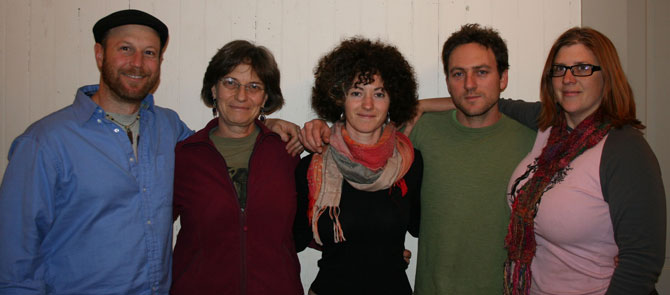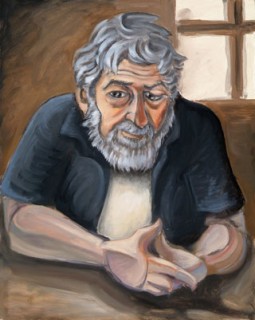In 2011, the North Columbia Schoolhouse Cultural Center received a grant from Cal Humanities to collect stories from residents of the San Juan Ridge. Throughout 2012, we steadily compiled over 30 hours of audio recordings from 18 interview sessions with a total of 21 people spanning 34 to 94 years in age. Painted and photographed portraits of the interviewees were also created over that time. Stories from the interviews ranged from what it was like to be a child during the Great Depression living subsistent to the parable of a principled, punked-out teenager running for Nevada City Council during the late 1990s – and almost winning.
“A Landscape Full of Stories” is not intended to be an exhaustive oral history. We are merely presenting one particular vista through time and place of the vast, ever-changing terrain of the San Juan Ridge community. The choice to combine portraits, written excerpts and audio recordings was made to provoke different senses of perception and to consider how we might experience a person through different media.
We selected excerpts based on several criteria: significance to the life of the person (or persons) interviewed; whether a story stood on its own merit simply as a good yarn; relevance and importance to the history of the San Juan Ridge community; and the capacity of a story to express an essential quality of the person, or – for that matter – our collective humanity: humor, depth, forthrightness, creativity, diligence, remorse, courage and so on.
It may be helpful to view the portrait and listen to the audio recording first, so that when you read the written excerpt, you’ll have the image and voice of the subject in your mind. You are, of course, welcome to experiment with your own iterations of the material. To maintain and convey the rhythm of dialogue, we have decided to leave the written excerpts mainly unedited. However, in some cases minor changes have been made for the sake of clarity and to acknowledge that the spoken word doesn’t always transfer to the written page as eloquently as we might like.

A team full of extraordinarily committed individuals produced “A Landscape Full of Stories.” We would like to thank first our inimitable advisors, Steve Sanfield and Gary Snyder, for providing essential guidance on how to collect a story with integrity and purpose; Catherine Stifter, for writing the grant application and bringing a high standard of excellence and professionalism, especially to the audio recording; Shana Maziarz, for collaborating on the early vision of the project and being integral to securing the grant; Aram Larsen and Rebecca Seary, for their ability to see a person and then skillfully translate that essence onto a canvas; Samantha Hinrichs, for her keen eye, vivacious spirit, and whose rich knowledge of the San Juan Ridge was invaluable for choosing who to interview; John Tecklin and Hank Meals for volunteering to conduct the interviews of Howard Miser and Gene Covert, respectively; and Jeff Adams, for directing the coordination of the project, completing the arduous task of selecting and editing the excerpts, and converting all the material into a featured piece of the Schoolhouse’s new website.
And of course, we are so grateful to the 21 folks from our community who agreed to open up and share their stories. On behalf of everyone, thank you:
Arlo Acton & Robyn Martin
Ed Boast
Gene Covert
Ginger Covert, Shelly Covert & Alberta Gallez
Doc Dachtler
Robert Erickson
Rainy Blue Cloud Greensfelder
Bob Greensfelder
John Konze
Fred Langdon
Erin Noel
Hank Meals
Laughter Medicine
Howard Miser
Joseph Selbie
Toki Steele
Jerry Tecklin
John Tecklin
This project was made possible with support from Cal Humanities, an independent non-profit state partner of the National Endowment for the Humanities. For more information, visit www.calhum.org.
Any views, findings, conclusions, or recommendations expressed in this website do not necessarily represent those of Cal Humanities or the National Endowment for the Humanities.


